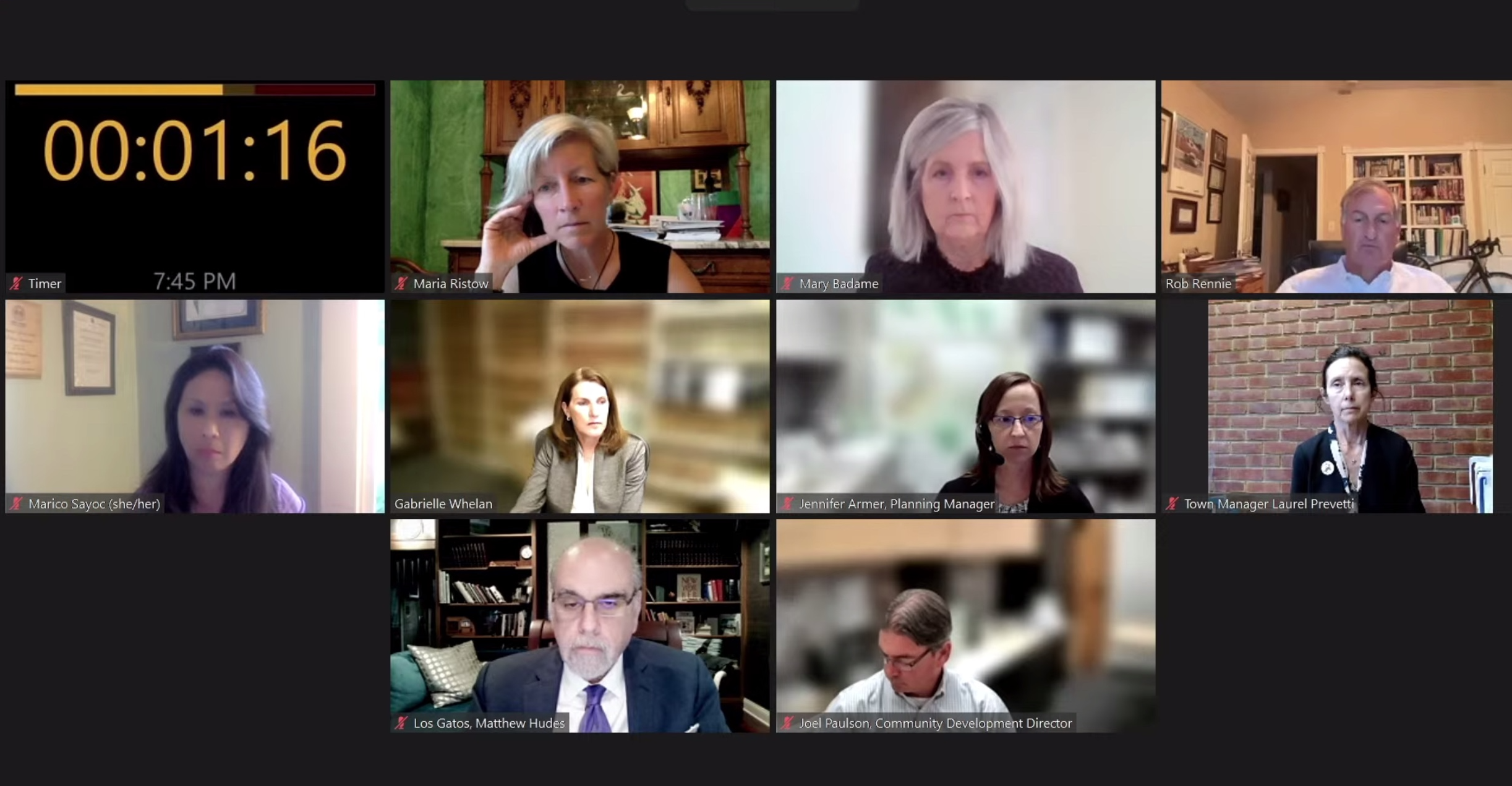The hard-won consensus achieved by the Planning Commission about what housing should be built in Los Gatos was shattered by multiple stones as Council took up the General Plan Monday.
It included a broadside by Mayor Rob Rennie, who proposed introducing an entirely new zoning category in some areas in order to prevent any additional development on the more-traditional suburban parcels.
The meeting also featured a gambit by Councilmember Matthew Hudes to get Council to agree to a housing target staff said could violate State rules.
These were just two of many ideas considered by elected officials, about everything that could affect the town in the years to come—from environmental concerns to traffic patterns to social justice. But, as expected, the bulk of discussion and disagreement centered on the development outlined in the Land Use Element.
And all Council members sought to reduce the housing construction that would be possible in Los Gatos over the next 20 years—with the greatest focus on what happens with its single-family homes.
After a series of meetings earlier this year, the Planning Commission decided to recommend allowing 10 units per acre in Low Density Residential—a compromise between one commissioner who wanted an eight units per acre maximum and another commissioner who wanted to see 12 units per acre.
The original recommendation had been to allow up to 12 units per acre.
But in a special session of Council on Monday, Rennie—who tends to act as a facilitator and generally doesn’t try to steer toward a particular action—set the tone for Land Use Element discussions.
He suggested going all the way back to a maximum of five units per acre—what’s in the current General Plan—while allowing increased density in specific areas designated for growth away from the single-family homes.
This would prevent fourplexes and similar “missing middle” housing from being built in Low Density Residential, something the Planning Commission had specifically wanted to allow. A staff analysis found that fourplexes wouldn’t really be possible at under 10 units per acre in Low Density Residential.
Some Planning Commissioners had suggested distributing housing across town, rather than concentrating it in limited areas, would help reduce traffic bottlenecks.
Rennie said putting housing in Community Place Districts (which Council decided to call Community Growth Districts later in the meeting) would be easier on infrastructure and better for the environment.
Vice Mayor Maria Ristow noted new State laws make it easier to build accessory dwelling units (ADUs) and so-called SB9 lot-splits will still allow some development in Low Density Residential.
“I support the mayor’s position of potentially stepping back from that density in the LDRs,” she said.
This flew in the face of the efforts of the Planning Commission to steer developers away from SB9 development, which the Town doesn’t have much control over, and toward “missing middle” housing that would still fall under local control.
Councilmember Marico Sayoc said it was unclear what the impact of Rennie’s concept would be.
Rennie said his proposed zone (he threw out the name “LDR+”; staff said “Low-Medium Residential” was a possibility) would be for housing such as duplexes and fourplexes.
“The idea being, these are areas where people can easily walk to services, ride their bike easily,” he said. “If we have to add people, let’s put it in the place that’s going to minimize the impact on infrastructure.”
Staff said some of the parts of town that would be covered by Rennie’s proposed zoning class don’t even include Low Density parcels.
The term “missing middle”—which Planning Commissioners had taken a shine to—came under attack from Hudes, who said it was vague and subjective.
“I view it as a marketing term from developers to make something more attractive without describing what it is,” he said.
Council voted unanimously to rename “missing middle” housing to “small, multi-unit” residential.
Councilmember Mary Badame commented that her feeling is that “small” could mean 100-square-feet or less.
Rennie made a motion to direct staff to evaluate the impact of eliminating increased density in Low Density Residential and creating a new class for the Town’s planned community hubs.
Sayoc said it will be important to understand whether Rennie’s concept would impact the principle of allowing growth across town rather than limiting it to specific areas.
Staff previously found reverting to the 2020 General Plan levels would prevent 279 units from being built, although it’s unclear how many of these would still fall within the Community Growth Districts.
The motion was approved unanimously. Decisions won’t be final until the General Plan is adopted.
Anti-growth sentiments
Overall, the General Plan process has been an exercise in limiting development in the upscale community—known for being home to tech company founders and political donors—that Vice President Kamala Harris is planning to visit in the coming days.
In September, while trying to prepare for two decades of growth, staff anticipated 3,904 units of new and redeveloped housing.
By the time it emerged from Planning Commission, 624 homes had been eliminated—bringing the total down to 3,280 units.
But this didn’t quell the worries of some residents who spoke during Monday’s meeting.
Daniel Cooley, who’s been living in Los Gatos since 1958—and purchased his grandfather’s house in the early 1990s—said he’s “saddened” to see the Draft General Plan proceeding as-is.
“We know the future is upon us and we must be cognizant of that,” he said. “I do not want to see three or four-story condo buildings.”
Steve Rothenberg said he used to live in Palo Alto and considers that an example of bad development.
“Life in Palo Alto is nothing like it was when I first moved there,” he said, arguing against more housing.
Another public commenter, John Shepardson, said on the one hand it’s important to reverse decades of racism in housing policy that discriminated against Black people, but also shared he’s concerned if Los Gatos builds more housing it’ll only be forced by the State to build even more later.
Planning Manager Jennifer Armer said comments received while boothing at a local farmers’ market have been much more balanced than the anti-growth sentiments frequently expressed at Council.
Proposal shot down
In approximately the first eight years of the General Plan going into effect, the Town is required by the State to plan to build 1,993 homes, and it will likely have to include a 15% buffer of 299 units—so 2,292 in total. That’s under the Regional Housing Needs Allocation process.
Based on the current rate of ADU installs, the Town figures it can only count on including 25 of these a year toward the RHNA total—so 200 tops for the first eight-year cycle.
Hudes proposed a goal of only building just 2,292 homes over the next two decades (1,993 units plus the 15% buffer), and put it in the form of a motion.
Considering staff already expects 300 ADUs will be built after the first of three RHNA cycles is completed, he was asked to clarify if the ADUs would at least be in addition to his 2,292-unit goal. Hudes confirmed he meant only building 2,292 homes for the entire 20-year period covered by the General Plan (with a five-year review to track the progress).
He suggested Los Gatos is trying to double what’s required under RHNA; and he asked Los Gatos’ new Town Attorney, Gabrielle Whelan, if it’s true that residential densities can only be revised upwards and not downwards—something previously shared with planning commissioners by staff.
Whelan replied that her interpretation of the relevant law, Senate Bill 330, is that Los Gatos would be allowed to downshift the densities all the way back to the way things were on Jan. 1, 2018—so, current General Plan levels—at any point.
Armer said Los Gatos officials aren’t planning to build double what’s required by Sacramento.
Hudes argued the Town’s comparing apples and oranges in its analysis.
“It completely misses the point; it’s mixing 20- and eight-year numbers,” he said. “The proposal I’ve made is to adopt the RHNA allocation of 1,993 plus a 15% buffer for 20 years—not for eight years.”
Armer said this would be bad news for the Housing Element process, which must be approved by the California Department of Housing and Community Development, suggesting Hudes could land Los Gatos in legal jeopardy if followed.
“We can say with confidence that that would not leave capacity for the Housing Element,” she said of Hudes’ motion.
Town Manager Laurel Prevetti said if Council approves the motion, the rest of its Land Use decisions would be in service of this goal.
Sayoc said she didn’t want to box the Town into a corner at this point.
“We’ve been told that if we stick with the 1,993 as contained in the motion, we’re not going to have capacity for a Housing Element,” she said.
Ristow said she thinks Hudes’ number is “way too low,” although she didn’t propose a target of her own.
Both Sayoc and Ristow voted against.
Badame, who’d seconded the motion, voted for it.
So, as the minute hand ticked toward midnight, it was down to Rennie—who had previously voted for other housing-slashing measures throughout the course of the night.
He decided against, killing Hudes’ attempt at paving the way for a minimal-growth future for Los Gatos.
Council will pick its General Plan work back up on June 30.










